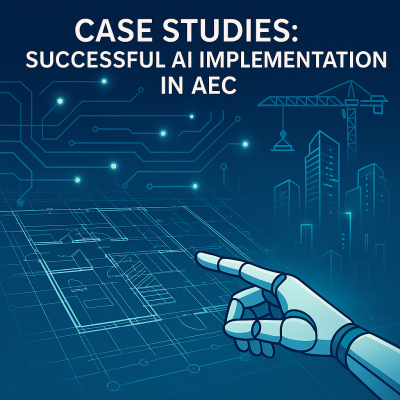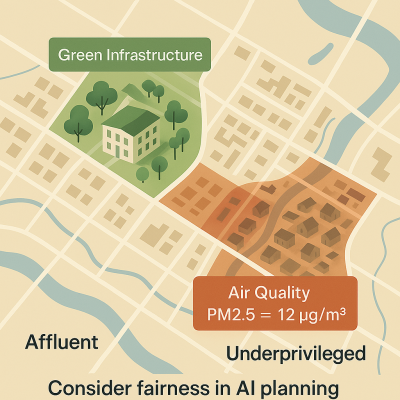
The Architecture, Engineering, and Construction (AEC) industry is undergoing a transformative shift as artificial intelligence (AI) becomes increasingly embedded in design, planning, and operations. While AI offers immense promise, its real-world applications tell the most compelling story. Across the globe, forward-thinking firms are implementing AI to streamline workflows, reduce costs, improve safety, and enhance sustainability.
In this article, we explore several real-world case studies that highlight successful AI implementation in AEC. These examples show how AI is not just theoretical hype—but a practical tool driving measurable results.
Case Study 1: AI for Risk Management at Skanska
Skanska, one of the world’s largest construction and development companies, implemented AI-driven analytics to improve safety and risk management across its job sites.
Challenge: Skanska needed a better way to predict and prevent on-site accidents, especially on large-scale infrastructure projects with high worker density.
Solution: By partnering with an AI analytics firm, Skanska deployed machine learning algorithms to analyze historical incident reports, weather data, project schedules, and sensor data from wearables.
Outcome:
Key Takeaway: AI can synthesize vast data sources to predict safety risks and improve job site health.
Case Study 2: Generative Design in Action — Gensler’s Office Layout Optimization
Global architecture firm Gensler used AI-powered generative design to plan a high-efficiency office for one of its tech clients.
Challenge: The client wanted an office that maximized team collaboration, access to daylight, and future flexibility.
Solution: Using Autodesk’s generative design engine, Gensler input spatial constraints, employee movement patterns, and daylight availability into the software. The AI generated hundreds of layout options optimized for collaboration and comfort.
Outcome:
Key Takeaway: Generative design offers rapid ideation and optimization based on real-world use patterns.
Case Study 3: Predictive Maintenance at Laing O’Rourke
UK-based contractor Laing O’Rourke deployed AI for predictive maintenance on heavy construction equipment to avoid costly downtime.
Challenge: The company experienced frequent unplanned equipment failures that delayed project timelines and increased maintenance costs.
Solution: By installing IoT sensors and using AI models to analyze performance data in real-time, Laing O’Rourke could predict when machines were likely to fail and service them preemptively.
Outcome:
Key Takeaway: AI enables smarter asset management, increasing reliability and reducing operational risk.
Case Study 4: BIM + AI for Clash Detection at Mortenson Construction
Mortenson Construction leveraged AI to enhance Building Information Modeling (BIM) clash detection and resolution.
Challenge: Traditional BIM coordination processes required manual clash detection that was time-consuming and error-prone.
Solution: Mortenson integrated AI with BIM tools to automatically detect, categorize, and prioritize design clashes between mechanical, structural, and architectural elements.
Outcome:
Key Takeaway: AI-enhanced BIM helps catch issues earlier, saving time and cost during construction.
Case Study 5: AI for Urban Planning in Singapore
Singapore’s Urban Redevelopment Authority (URA) has utilized AI to enhance urban planning decisions in one of the world’s densest cities.
Challenge: Managing land use, traffic, and environmental impact in a fast-growing metropolis requires rapid and informed decision-making.
Solution: The URA used machine learning models to analyze satellite imagery, demographic trends, and mobility data to simulate urban growth and test planning scenarios.
Outcome:
Key Takeaway: AI supports holistic urban planning by simulating future scenarios and guiding infrastructure investment.
Conclusion
From design studios to construction sites and urban planning agencies, AI is reshaping the AEC industry. These case studies highlight a common thread: AI works best when paired with domain expertise, high-quality data, and a willingness to adapt traditional workflows.
As more firms embrace AI, we’ll see broader adoption, better performance metrics, and even more innovative use cases emerge. For AEC professionals, the question is no longer “if” but “how” and “when” to integrate AI into their operations.

Artificial Intelligence (AI) is no longer a futuristic concept—it’s a present-day reality reshaping how architects and engineers design, build, and manage infrastructure. From automating routine tasks to optimizing complex simulations, AI empowers professionals to make better, faster, and more sustainable decisions. But to fully harness this power, engineers and architects must develop a new set of interdisciplinary skills.
This article outlines the essential skills needed to collaborate effectively with AI tools and technologies, helping industry professionals remain relevant and innovative in a rapidly evolving landscape.
At the heart of AI is data. Engineers and architects must understand how data is collected, processed, and used in AI applications. This includes:
Why it matters: AI systems can only make decisions based on the data they’re fed. Poor data quality leads to unreliable results, so professionals must know how to assess and improve their datasets.
While not everyone needs to be a software developer, understanding basic programming—especially in Python—opens doors to customizing AI workflows, tweaking scripts, and communicating with developers. Useful capabilities include:
Why it matters: Engineers and architects who can “speak AI” can collaborate more effectively with data scientists and tool developers, bridging the gap between technical teams and design practice.
The growing ecosystem of AI tools tailored to AEC (architecture, engineering, and construction) includes platforms for:
Professionals must stay up-to-date with relevant tools in their domain and learn how to evaluate them based on accuracy, usability, and transparency.
Why it matters: Tool literacy ensures that professionals can confidently integrate AI into their workflows and avoid over-reliance on black-box solutions.
AI can produce impressive results, but professionals must be prepared to critically evaluate those outputs. This includes:
Why it matters: AI should augment—not replace—human judgment. A strong ethical compass is essential to avoid blindly following AI-generated outputs that could be flawed or unjust.
AI often interacts with complex systems—whether that’s a building, a city, or an entire supply chain. Engineers and architects must understand:
Why it matters: A siloed understanding limits AI’s potential. Systems thinking helps professionals apply AI meaningfully across multiple project dimensions.
The best AI solutions come from interdisciplinary collaboration. Professionals must be able to:
Why it matters: Communication is key to ensuring that AI serves real-world project goals and that all stakeholders understand its benefits and limitations.
AI is evolving rapidly. Professionals who succeed will be those who continually upgrade their knowledge and adapt to emerging technologies. This means:
Why it matters: Staying relevant in an AI-enhanced industry requires more than mastering today’s tools—it demands curiosity, resilience, and a growth mindset.
Conclusion
As AI becomes a core part of design and engineering practice, professionals must move beyond traditional skill sets. From data fluency and programming to ethical reasoning and communication, a well-rounded toolkit will empower engineers and architects to not only use AI effectively—but to shape its future.
Whether you’re an early-career professional or a seasoned expert, investing in these skills will help you stay competitive and creatively empowered in a world where human and machine intelligence increasingly work hand in hand.

Artificial intelligence (AI) is transforming how we design buildings, manage infrastructure, and respond to environmental challenges. In architecture, AI aids generative design and space optimization. In engineering, it enhances simulation and predictive modeling. In environmental science, it enables smarter monitoring and resource management. However, with these advancements come pressing ethical questions.
As we delegate more decision-making power to algorithms, we must ask: Who is accountable? How do we prevent bias? Are these tools being used to benefit society—or merely to maximize profit? This article explores the ethical dimensions of AI integration in the fields of architecture, engineering, and environmental management, highlighting the responsibilities of professionals and developers alike.
AI systems often function as black boxes, making recommendations or decisions without clearly explaining how they were reached. In architecture and engineering, this opacity can have real consequences. For example:
Solution: Ethical AI use requires transparency. Designers and engineers must document how models are trained, what data was used, and how outputs are interpreted. Explainable AI (XAI) systems should be prioritized, allowing stakeholders to audit and question decisions.
AI models are only as unbiased as the data used to train them. If historical design or planning data reflects inequities—such as systemic neglect of low-income neighborhoods—AI could perpetuate these biases. In environmental applications, this can manifest as:
Solution: Ethical practice demands inclusive data sourcing, active bias auditing, and community involvement. AI should enhance environmental justice, not undermine it.
Smart buildings and infrastructure are increasingly equipped with AI-powered sensors, cameras, and monitoring tools. While these systems can improve efficiency and safety, they also raise concerns about surveillance and data privacy:
Solution: Ethical guidelines must prioritize informed consent, data anonymization, and clear data governance policies. Privacy should be built into the design of AI systems, not treated as an afterthought.
AI systems can automate many tasks traditionally performed by architects, engineers, and environmental scientists. While this boosts productivity, it also poses ethical questions about employment, skill development, and human dignity:
Solution: Instead of replacing humans, AI should augment human expertise. Ethical implementation involves retraining programs, equitable access to AI tools, and preserving opportunities for human creativity and judgment.
Ironically, while AI is often used to fight climate change, training large models consumes enormous energy. Engineering simulations, generative design, and smart city planning tools powered by AI all have a carbon cost.
Solution: Ethical AI use in sustainability must account for its own environmental impact. This includes:
When AI is used for projects in culturally diverse or indigenous communities—such as land-use planning or conservation—ethical risks increase. Imported models may not account for local knowledge systems, cultural values, or sovereignty.
Solution: Ethical AI deployment must include:
Conclusion
As AI becomes more embedded in architecture, engineering, and environmental decision-making, ethical considerations must evolve from side notes to central pillars. Professionals must advocate for responsible practices, developers must design transparent and inclusive systems, and regulators must establish clear frameworks for AI accountability.
Ultimately, ethics in AI is not just about avoiding harm—it’s about actively using technology to build a more just, equitable, and sustainable world.